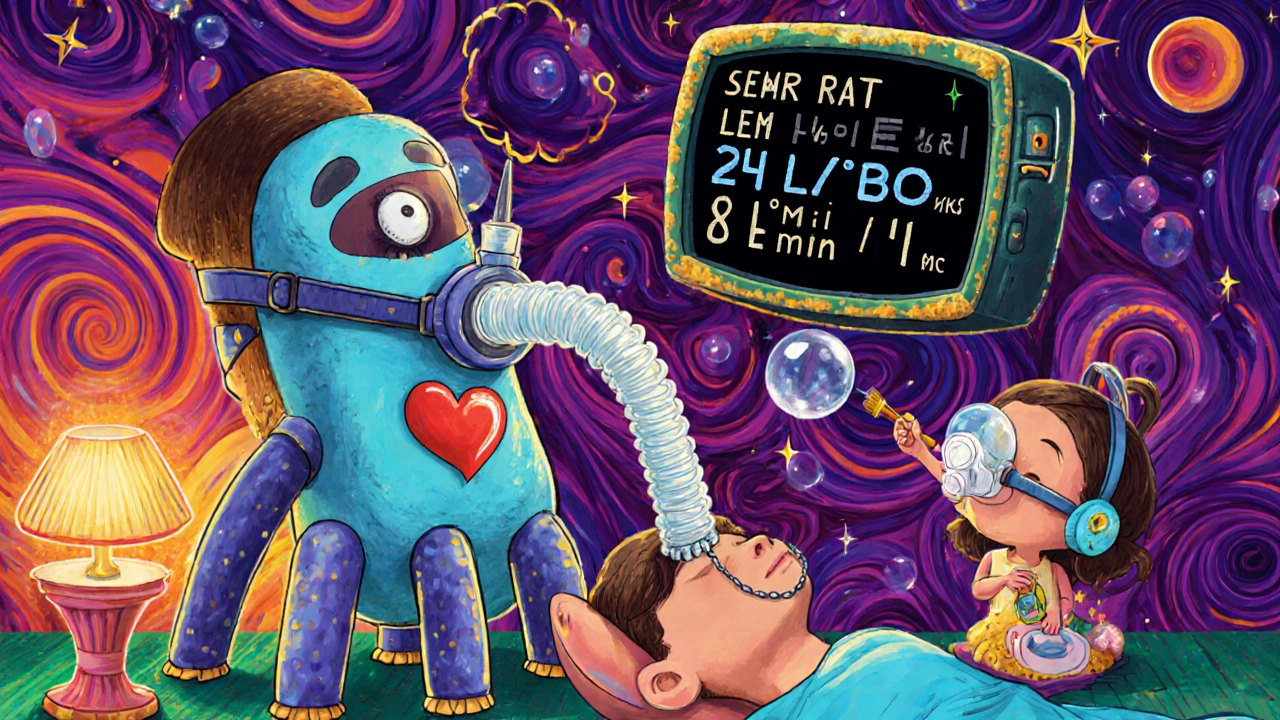Waking up with a dry mouth, hearing air hiss from your mask, or feeling like the pressure is too high or too low - these aren’t just minor annoyances. They’re the top reasons people quit using their CPAP machine. If you’re one of the 45% of users who struggle with compliance, you’re not broken. You just need the right fixes. CPAP therapy works - studies show it cuts sleep apnea events by 70-90% and lowers heart risks over time - but only if you can sleep through the night without discomfort.
Why Your Mouth Feels Like Desert Sand
Dry mouth isn’t caused by your humidifier not working hard enough. It’s caused by your mouth being open while you sleep. When air escapes through your mouth, it dries out your throat and tongue. That’s why 42% of CPAP users report this problem, according to sleep specialist Dr. Raj Dasgupta.The fix isn’t always cranking up the humidifier. In fact, turning the heat too high can cause condensation in your tubing - a problem called "rainout" - which makes things worse. Instead, try these three proven steps:
- Switch to a full-face mask. These cover both nose and mouth, so air can’t escape. One Reddit user, u/SleepSeeker2020, said dry mouth vanished within three nights after switching.
- Use a chin strap. These simple fabric straps hold your jaw closed. Around 45% of mouth breathers use them successfully.
- Turn on heated tubing. If your machine has it (like the ResMed AirSense 11 or Philips DreamStation 2), set it to medium heat. Philips’ 2022 trial showed heated tubing reduces dry mouth by 32%.
Don’t just rely on the humidifier’s default setting. Most machines have a scale from 0 to 6. Start at level 3 or 4. If you still wake up thirsty, go up one notch. If you see water pooling in your tube, drop it down.
Mask Leaks: The Silent CPAP Killer
A leak isn’t just noisy. Dr. David White from Harvard says leaks over 24 L/min can cut therapy effectiveness in half. You might think your mask is tight enough - but if you’re still hearing air, it’s not sealed right.Most leaks come from three places: the cushion, the headgear, or your face shape changing overnight. Here’s how to fix them:
- Replace the cushion every 3 months. Silicone breaks down. Even if it doesn’t look worn, it loses its seal. Nearly 92% of DME providers recommend this.
- Adjust the headgear, don’t over-tighten. Pulling straps too tight causes pressure sores and actually makes leaks worse. Try the "airflow test": turn on your machine, then gently pull each strap until the hissing stops. Usually, you need 3 to 5 small adjustments.
- Check your mask size. If you’ve lost or gained weight, your face shape changed. A mask that fit last year might not fit now. Most brands offer multiple cushion sizes - try a small or large one before buying a new mask.
Modern machines like the ResMed AirSense 11 detect leaks as small as 12 L/min and show you the numbers in the app. If your leak rate is consistently above 20 L/min for more than 3 nights, it’s time to act. Don’t wait until you’re miserable.

Pressure Too High? Too Low? Here’s What to Do
Feeling like the machine is pushing air too hard? Or not enough? Pressure issues are the #2 complaint on Amazon CPAP reviews. But here’s the truth: most people don’t need the pressure their doctor set months ago.Auto-adjusting CPAPs (APAP) like the ResMed AirSense 11 AutoSet or Philips DreamStation 2 change pressure every 5 to 10 seconds based on your breathing. That’s great - but they still need to start in the right range. If your pressure is stuck at 14 cm H2O and you’re gasping, you might need it lowered. Dr. Nancy Collop from Johns Hopkins says many patients do just fine at 5-8 cm H2O, especially with expiratory pressure relief (EPR) turned on.
Here’s what to do:
- Check your machine’s data. Look at your average pressure over the last 30 days. If it’s consistently below 8 cm H2O, your setting might be too high.
- Turn on EPR or C-Flex (depending on brand). This lowers pressure when you breathe out. Many users say it feels like the machine "listens" to them.
- Don’t adjust pressure yourself. ResMed’s policy says changing pressure beyond ±2 cm H2O voids your warranty. Talk to your sleep specialist. They can run a new titration study or adjust your settings remotely if your machine supports telehealth (now covered by Medicare since January 2024).
One user on Reddit, u/ExhaustedEngineer, had pressure set at 14 cm H2O and felt chest pain. After a doctor dropped it to 9 cm H2O with EPR enabled, he slept through the night for the first time in years.
What You’re Probably Doing Wrong
Most people think CPAP troubleshooting is about buying better gear. It’s not. It’s about consistency and small adjustments.Here are the top three mistakes:
- Skipping the acclimation period. It takes 2-4 weeks to get used to CPAP. Don’t give up after 3 nights. Sleep specialists say 78% of users master basic fixes within 14 days.
- Ignoring filter changes. Foam filters need replacing every 30 days. HEPA filters every 90. A clogged filter makes the machine work harder, which can increase noise and reduce airflow.
- Not cleaning your equipment. Wash your mask cushion and tubing weekly with mild soap. Mold and oil buildup cause leaks and skin irritation. Lincare’s 2023 survey found 89% of users who followed cleaning videos reported better comfort.
Also, don’t ignore your machine’s alerts. If it says "high leak" or "low pressure," don’t just ignore it. Open the app. Check the data. Most modern machines give you clear answers - you just have to look.

When to Call Your Sleep Doctor
You don’t need to fix everything alone. But you also shouldn’t wait until you’re miserable. Call your provider if:- Your leak rate stays above 24 L/min for more than 3 nights in a row.
- You’re still waking up with a dry mouth after trying a chin strap and heated tubing.
- You feel chest pressure, headaches, or bloating - these can signal pressure too high.
- Your machine shows frequent apnea events despite therapy (AHI above 5).
Many clinics now offer telehealth CPAP check-ins. Medicare covers them. You can often get pressure adjustments without leaving your house.
What’s Next for CPAP Tech
The future is smarter. ResMed’s upcoming S+ algorithm (coming in Q2 2024) promises 23% better leak compensation. Philips’ DreamMapper app already gives personalized pressure tips based on your 30-day usage. And by 2027, nearly half of all CPAP machines will sync with smartwatches to track sleep quality in real time.But tech won’t fix a bad mask fit or a dirty filter. The best machine in the world won’t help if you’re not using it right. The goal isn’t perfection. It’s consistency. Even 4 hours a night, 5 nights a week, cuts your heart risk by 30% over five years.
If you’re struggling, you’re not failing. You’re just one adjustment away from better sleep.
Why does my CPAP make my mouth dry even with a humidifier?
Dry mouth from CPAP is almost always caused by mouth breathing, not a weak humidifier. Air escapes through your mouth, drying out your throat. The solution isn’t more humidity - it’s stopping the leak. Try a full-face mask or a chin strap. Heated tubing also helps reduce dryness by keeping air warm and moist all the way to your airway.
How do I know if my CPAP mask is leaking too much?
If you hear loud hissing, wake up with a dry mouth, or your machine shows leak rates over 24 L/min for multiple nights, your mask is leaking too much. Check the seal around your nose and mouth. Make sure the cushion isn’t cracked or worn. Adjust headgear straps gently - don’t over-tighten. Most machines have leak reports in their app or on-screen display. Look for patterns: does it leak more when you turn over? That’s usually a fit issue.
Can I adjust my CPAP pressure myself?
Most CPAP machines let you change pressure by ±2 cm H2O, but doing so voids your warranty according to ResMed’s policy. You should never adjust pressure without talking to your sleep doctor. Too high can cause chest pain or bloating. Too low won’t treat your apnea. Auto-adjusting machines (APAP) handle this automatically, but they need to be set in the right range. Your doctor can remotely adjust settings if your device supports telehealth - which Medicare now covers.
How often should I replace my CPAP mask parts?
Replace the mask cushion every 3 months - even if it looks fine. Silicone breaks down from skin oils and cleaning. Headgear straps should be replaced every 6 months as they stretch out. Filters need changing every 30 days for foam and every 90 days for HEPA. Cleaning your equipment weekly prevents buildup that causes leaks and skin irritation. Most DME providers recommend replacing parts on this schedule to keep therapy effective.
Is it normal to feel pressure in my ears or chest with CPAP?
Mild ear pressure when you first start is common - it’s like flying. But ongoing chest pressure, pain, or bloating means your pressure is likely too high. Try turning on expiratory pressure relief (EPR or C-Flex), which lowers pressure when you breathe out. If that doesn’t help, your pressure setting may need to be lowered. Talk to your sleep specialist. High pressure can also cause aerophagia (swallowing air), which leads to gas and discomfort.
Why do some people give up on CPAP even though it works?
The biggest reason is discomfort - dry mouth, mask leaks, and pressure that feels too strong. Many users expect instant comfort, but it takes 2-4 weeks to adjust. Others don’t know how to fix small problems. They think it’s broken, not that it just needs a tweak. With the right mask, proper cleaning, and smart pressure settings, most people can get past these issues. The key is persistence and knowing where to get help - whether it’s a DME provider, online community, or sleep clinic.
Does Medicare cover CPAP repairs and replacements?
Yes. Medicare covers 80% of the cost of CPAP machines and accessories like masks, tubing, and humidifiers if you have a prescription and meet adherence requirements (4+ hours per night for 70% of nights over 30 days). Replacements for worn parts like cushions and filters are covered under the rental agreement. Telehealth CPAP management is now covered since January 2024, so you can get adjustments without in-person visits. Always check with your DME supplier to confirm what’s included.

Lemmy Coco
November 20, 2025 AT 13:46i switched to a full-face mask after 3 weeks of dry mouth hell and holy crap it was like night and day. no more waking up with my tongue stuck to the roof of my mouth. also heated tubing? game changer. i had no idea it even existed until someone mentioned it here. thanks for the tip, whoever wrote this post.
rob lafata
November 21, 2025 AT 13:10you people are pathetic. you can’t even sleep with a mask on? my grandpa used to sleep with a tin can taped to his face back in ’78 and he didn’t whine about rainout or chin straps. get a spine. if you can’t handle 8 cm H2O, maybe you don’t deserve to breathe at night.
serge jane
November 21, 2025 AT 19:49it’s interesting how we treat CPAP like a machine that needs fixing rather than a tool that needs integration into our biology. the body adapts slowly, and we demand instant results. the dry mouth isn’t a malfunction-it’s a signal that your autonomic nervous system is resisting the intrusion. maybe the real issue isn’t the mask or the pressure but our impatience with the quiet surrender sleep requires. i’ve been using this for six years and still adjust my headgear every night like it’s a ritual. it’s not about perfection. it’s about showing up.
Nick Naylor
November 23, 2025 AT 16:09Brianna Groleau
November 24, 2025 AT 08:29oh my god i just realized i’ve been cleaning my mask with dish soap for a year?? i thought it was fine because it looked clean. now i’m crying a little because my skin has been irritated for months and i thought it was allergies. i’m going to buy the special wipes tomorrow. thank you for saying this. i feel less alone. also, i’m going to try the chin strap. i’ve been too scared to try anything new but now i think i can do it.
Rusty Thomas
November 24, 2025 AT 16:53so i tried the heated tubing and it worked for like 2 days then my tube filled with water and i woke up with a wet pillow and i screamed. now i’m back to my old mask and i just sleep with a water bottle next to me. also i think my dog is judging me. he stares. i’m not sure if he’s worried or just bored.
Sarah Swiatek
November 25, 2025 AT 03:52the fact that people think pressure adjustments are a DIY project is honestly terrifying. i had a friend who lowered his pressure from 12 to 6 because he "felt like it"-two weeks later he was in the ER with oxygen saturation at 82%. your machine isn’t a video game controller. it’s a life-support device. and yes, i’m being dramatic. but if you’re not calling your sleep doctor, you’re gambling with your heart. and your heart doesn’t get a second chance.
swatantra kumar
November 25, 2025 AT 12:03bro i’m from india and we don’t even have CPAP machines in half the villages. you guys complain about rainout and i’m over here using a fan and a plastic bag. 😅 but seriously, thanks for this. i’m getting one next month. my dad has apnea and he’s too proud to admit he’s tired all day. maybe this will help him. 🙏
robert cardy solano
November 27, 2025 AT 01:23my mask leaks when i roll over. that’s it. no drama. no new gear. i just put a folded towel under my shoulder. works every time. also, don’t overthink the humidifier. 3 is fine. stop scrolling. go to bed.
Cinkoon Marketing
November 27, 2025 AT 08:25just a heads up-Medicare doesn’t cover telehealth adjustments unless you’ve had an in-person visit in the last 12 months. just checked with my DME. you’re all getting misinformation from Reddit. i’ve been doing this for 10 years. don’t trust random posts. call your provider. really.